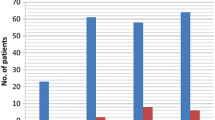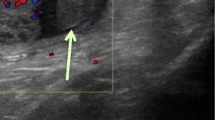Abstract
The acute scrotum in the paediatric population is a clinical dilemma where a definitive diagnosis can only truly be made at surgical exploration. We postulate that surgical exploration in all cases allows truly accurate diagnoses, treats the torted appendage testes and enables the validity of clinical signs associated with scrotal pathology to be assessed. We retrospectively reviewed all boys less than 15 years old who presented to our institution with scrotal pain over a 2 year period. A total of 121 patients attended of whom 113 had exploratory surgery, 31 (27%) had testicular torsion, 64 (57%) had a torted appendage testis, 12 (11%) had epididymitis, 1 (1%) had fat necrosis and 5 (4%) had no abnormality detected. On exploration 9 (29%) of the torted testis were unsalvageable and thus required excision. The initial clinical impression was frequently demonstrated to be flawed. Two patients with testicular torsion presented with a painless swelling and two further patients had necrotic testes despite a history of pain for less than 4 h. A normal cremasteric reflex and a visible blue dot were detected in boys with testicular torsion. Doppler ultrasound scans were not reliable with 50% sensitivity to clearly differentiate between torsion of the testis and that of the appendage testis. Absolute dependence on clinical features can lead to a misdiagnosis of testicular torsion. The surgical treatment of torted appendage testis is safe, allowing accurate diagnosis and pain relief with minimal morbidity. Early scrotal exploration of all cases with testicular pain ensures maximal testicular salvage.
Similar content being viewed by others
References
Beasley SW (1999) The acutely painful scrotum in children: how to avoid the traps in diagnosis. N Z Med J 112:375–376
Merenciano Cortina FJ, Amat Cecilia M, Rafie Mazketli W, Romero Perez P (1998) Acute scrotum without technology. Actas Urol Esp 22:37–42
Lam WW, Yap TL, Jacobsen AS, Teo HJ (2005) Colour doppler ultrasonography replacing surgical exploration for acute scrotum: myth or reality? Pediatr Radiol 35:597–600
Anderson PA, Giacomantonio JM (1985) The acutely painful scrotum in children: review of 113 consecutive cases. Can Med Assoc J 132:1153–1155
Mushtaq I, Fung M, Glasson MJ (2003) Retrospective review of paediatric patients with acute scrotum. ANZ J Surg 73:1–2
Fisher R, Walker J (1994) The acute paediatric scrotum. Br J Hosp Med 51:290–292
Hastie KJ, Charlton CA (1990) Indications for the management of acute scrotal pain in children. Br J Surg 77:309–311
Holland JM, Graham JB, Ignatoff J (1981) Conservative management of torted appendage testis. J Urol 125:213–214
Rabinowitz R (1984) The importance of the cremasteric relflex in acute scrotal swellings in the child. J Urol 132:89–90
Sidler D, Brown RA, Millar AJ, Rode H, Cywes S (1997) A 25-year review of acute scrotum in children. S Afr Med J 87:1696–1698
Kass EJ, Stone KT, Cacciarelli AA, Mitchell B (1993) Do all children with acute scrotum require exploration. J Urol 150:667–669
Melekos MD, Asbach HW, Markou SA (1998) Etiology of acute scrotum in 100 boys with regard to age distribution. J Urol 139:1023–1025
Williamson RC (1976) Torsion of the testis and allied conditions. Br J Surg 63:465–476
Cuckow PM, Frank JD (2000) Torsion of the testis. BJU Int 86:349–353
Haynes BE, Besson HA, Haynes VE (1983) The diagnosis of testicular torsion. JAMA 249:2522–2527
Merlini E, Rotundi F, Seymandi PL, Canning DA (1998) Acute epididymitis and urinary tract anomalies in children. Scand J Urol Nephrol 32:273–275
Hermann D (1989) The pediatric acute scrotum. Pediatr Ann 18:198–202
Galejs LE, Kass EJ (1998) Color doppler ultrasound evaluation of the acute scrotum. Tech Urol 4:182–184
Weber DM, Rosslein R, Fliegel C (2000) Color doppler sonography in the diagnosis of acute scrotum in boys. Eur J Pediatr Surg 10:235–241
Kass EJ, Lundak B (1997) The acute scrotum. Pediatr Clin North Am 44:1251–1266
Steinhardt GF, Boyarsky S, Mackey R (1993) Testicular torsion: pitfalls of colour doppler sonography. J Urol 150:461–462
Dunne PJ, O’Loughlin BS (2000) Testicular torsion: time is the enemy. Aust N Z Surg 70:441–442
Author information
Authors and Affiliations
Corresponding author
Rights and permissions
About this article
Cite this article
Murphy, F.L., Fletcher, L. & Pease, P. Early scrotal exploration in all cases is the investigation and intervention of choice in the acute paediatric scrotum. Ped Surgery Int 22, 413–416 (2006). https://doi.org/10.1007/s00383-006-1681-0
Accepted:
Published:
Issue Date:
DOI: https://doi.org/10.1007/s00383-006-1681-0




